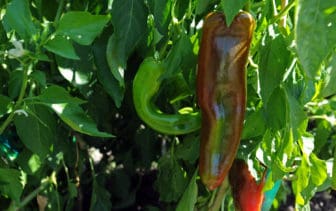Upon reading about the decline of New Mexico chile and the growth of the industry in Chihuahua, many are talking about the importance of supporting our state’s most high-profile crop.

Robert Yee / New Mexico State University
There are thousands of varieties of chile peppers grown across the world, like this chile growing at the organic farm, The No Cattle Company, in The Mimbres Valley in New Mexico.
“It is vital that we support our local economy and local workers,” John J. Cordova of Albuquerque wrote during discussions NMPolitics.net facilitated on Facebook. “Globalization is a corporate scam to undercut the middle class and living wages for local workers. Shop local, buy local and remember that free enterprise moves money to the elites and doesn’t trickle down.”
Not all agreed, however. Gus Coblentz of Santa Fe wrote that Chihuahua’s chile “is indistinguishable from that grown in our state, aside from the fact that it is cultivated using far less herbicides and pesticides due to the prohibitive costs associated with those chemicals to farmers working within the Mexican economy.”
“Bottom line, a better product, a safer product, and a lower price to the consumer,” he wrote.
The discussions came when NMPolitics.net recently published two articles from the U.S.-Mexico border news service Frontera NorteSur. The first highlighted the decline of chile grown in New Mexico since the implementation of the North American Free Trade Agreement (NAFTA). In 1992, the year before Washington approved NAFTA, we harvested 34,500 acres of chile in New Mexico. That compares with only 7,700 acres in 2014.
Meanwhile, as the second article reported, some 78,000 acres are under cultivation this year in Chihuahua, with about 26,000 acres of that being imported into the United States.
“All our jobs are being lost to other countries,” Diane Martinez of Bosque Farms wrote. “Chile just the latest.”
“Looks like NAFTA cancelled prosperity from NM chile,” wrote Cindy Madrid of Socorro.
On the other hand, Michelle C. Melendez of Albuquerque had these questions:
“Where do you think the word chile comes from? Where do you think it has been cultivated for millennia?”
Is New Mexico chile better?
Not all agreed with Coblentz’s assertion that the chile grown in Chihuahua is “indistinguishable” from the chile grown here.
“Another bad economic outcome from the ill-conceived NAFTA debacle. But this is Mexican chile. I’m sure the people in NY and NJ can’t tell the difference, but intelligent people can, and this Mexican stuff is junk,” Mike Johnson of Santa Fe wrote.
Others weren’t so sure. That includes Steve Reynolds of Las Cruces, who drives to Hatch every year to get his chile.
“I probably have a good chance — not 100 percent — of getting the real thing,” Reynolds wrote. “I don’t imagine we’ll ever see a good, objective comparison. I wouldn’t want to wager on being able to tell them apart.”
About the growth of Chihuahua chile, Tito Meyer of Las Cruces wrote, “Good for them. Our chile is uniquely better. If so, we are fine.”
Not so, Gene Baca of Corrales wrote in response, pointing out the drop in New Mexico chile acreage over the last two decades.
“Don’t be fooled by cheap imitations. Look for the New Mexico Chile Association certified chile logo, which is actually verified to be real New Mexico chile,” Baca wrote. “If you don’t, your grandkids will ask you to tell them stories about the New Mexico chile we had in the old days.”